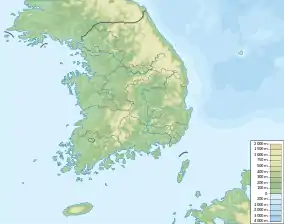Haman Formation
The Haman Formation is an Early Cretaceous geological formation in South Korea. It has been dated to the Albian, with an estimated maximum depositional age of 105.4 ± 0.4 Ma.[1] The deposit is known for its tracks, including those of dinosaurs,[2][3] pterosaurs and birds.[4][5][6] It overlies the Silla Congomerate which overlies the Chilgok Formation. It is laterally equivalent to the Sagog Formation.[7]
| Haman Formation Stratigraphic range: Albian ~105.4 Ma | |
|---|---|
| Type | Geological formation |
| Unit of | Hayang Group |
| Underlies | Jindong & Banyawol Formations |
| Overlies | Silla Conglomerate, Hagbong volcanics |
| Lithology | |
| Primary | Sandstone |
| Other | Siltstone, shale |
| Location | |
| Coordinates | 35.8°N 128.8°E |
| Approximate paleocoordinates | 44.4°N 125.2°E |
| Region | Gyeongsangnam-do |
| Country | |
| Extent | Gyeongsang Basin |
 Haman Formation (South Korea) | |
Vertebrate paleofauna
Fossil pterosaur tracks have been recovered from the formation.
Pterosaurs
| Pterosaurs | ||||
|---|---|---|---|---|
| Taxa | Presence | Description | Images | |
| Ichnogenus: | Sinsu and Haman[8] | Haman specimens housed at Korea National University of Education, Cheongwongun, South Korea.[8] | ||
See also
References
- Lee, Tae-Ho; Park, Kye-Hun; Yi, Keewook (October 2018). "Nature and evolution of the Cretaceous basins in the eastern margin of Eurasia: A case study of the Gyeongsang Basin, SE Korea". Journal of Asian Earth Sciences. 166: 19–31. doi:10.1016/j.jseaes.2018.07.004.
- Kim, Jeong Yul; Lockley, Martin G. (January 2012). "New Sauropod Tracks (Brontopodus pentadactylus ichnosp. nov.) from the Early Cretaceous Haman Formation of Jinju Area, Korea: Implications for Sauropods Manus Morphology". Ichnos. 19 (1–2): 84–92. doi:10.1080/10420940.2012.664056. ISSN 1042-0940.
- Kim, Jeong Yul; Kim, Kyung Soo; Lockley, Martin G.; Yang, Seong Young; Seo, Seung Jo; Choi, Hyun Il; Lim, Jong Deock (May 2008). "New didactyl dinosaur footprints (Dromaeosauripus hamanensis ichnogen. et ichnosp. nov.) from the Early Cretaceous Haman Formation, south coast of Korea". Palaeogeography, Palaeoclimatology, Palaeoecology. 262 (1–2): 72–78. doi:10.1016/j.palaeo.2008.02.003.
- Kim, Jeong Yul; Kim, Sam Hyang; Kim, Kyung Soo; Lockley, Martin (February 2006). "The oldest record of webbed bird and pterosaur tracks from South Korea (Cretaceous Haman Formation, Changseon and Sinsu Islands): More evidence of high avian diversity in East Asia". Cretaceous Research. 27 (1): 56–69. doi:10.1016/j.cretres.2005.10.005.
- Kim, Jeong Yul; Lockley, Martin G.; Seo, Seung Jo; Kim, Kyung Soo; Kim, Sam Hyang; Baek, Kwang Seok (January 2012). "A Paradise of Mesozoic Birds: The World's Richest and Most Diverse Cretaceous Bird Track Assemblage from the Early Cretaceous Haman Formation of the Gajin Tracksite, Jinju, Korea". Ichnos. 19 (1–2): 28–42. doi:10.1080/10420940.2012.660414. ISSN 1042-0940.
- Falk, A. R.; Hasiotis, S. T.; Martin, L. D. (2010-11-01). "FEEDING TRACES ASSOCIATED WITH BIRD TRACKS FROM THE LOWER CRETACEOUS HAMAN FORMATION, REPUBLIC OF KOREA". PALAIOS. 25 (11): 730–741. doi:10.2110/palo.2010.p10-057r. ISSN 0883-1351.
- Lee, J. I.; Lee, Y. I. (2000-01-01). "Provenance of the Lower Cretaceous Hayang Group, Gyeongsang Basin, Southeastern Korea: Implications for Continental-Arc Volcanism". Journal of Sedimentary Research. 70 (1): 151–158. doi:10.1306/2DC40906-0E47-11D7-8643000102C1865D. ISSN 1527-1404.
- Lockley, M.; Harris, J.D.; and Mitchell, L. 2008. "A global overview of pterosaur ichnology: tracksite distribution in space and time." Zitteliana. B28. p. 187-198. ISSN 1612-4138.
This article is issued from Wikipedia. The text is licensed under Creative Commons - Attribution - Sharealike. Additional terms may apply for the media files.